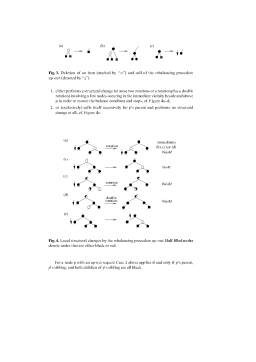Extras din curs
Abstract. Relaxed balancing means that, in a dictionary stored as a balanced tree, the
necessary rebalancing after updates may be delayed. This is in contrast to strict balancing
meaning that rebalancing is performed immediately after the update. Relaxed balancing
is important for efficiency in highly dynamic applications where updates can occur in
bursts. The rebalancing tasks can be performed gradually after all urgent updates, allowing
the concurrent use of the dictionary even though the underlying tree structure is not
completely in balance. In this paper we propose a new scheme of how to make known
rebalancing techniques relaxed in an efficient way. The idea is applied to the red-black
trees, but can be applied to any class of balanced trees. The key idea is to accumulate
insertions and deletions such that they can be settled in arbitrary order using the same
rebalancing operations as for standard balanced search trees. As a result it can be shown
that the number of needed rebalancing operations known from the strict balancing scheme
carry over to relaxed balancing.
1 Introduction
A dictionary is a scheme for storing a set of data such that the operations search, insert,
and delete can be carried out efficiently. Standard implementations of dictionaries using
balanced search trees like red-black trees, AVL-trees, half-balanced trees, and others
presuppose that each update operation is followed by a sequence of rebalancing steps
which restore the respective balance condition. Maintaining the balance conditions assures
that the trees cannot degenerate into linear lists and search and update operations
can be performed in a number of steps which is always logarithmic in the number of
keys stored in a tree.
In a concurrent environment, however, uncoupling the updating (insertion and deletion)
from the rebalancing transformations may increase the possible amount of concurrency
and speed up updates considerably. This leads to the notion of relaxed balance.
Instead of requiring that the balance condition is restored immediately after each update
operation the actual rebalancing transformations can be delayed arbitrarily and
interleaved freely with search and update operations.
Relaxed balancing was first suggested in [8] for red-black trees. The first actual
solution, presented by Kessels [10], is for relaxed balancing in AVL-trees [1] where
the allowed updates are only insertions. Nurmi et al. [14] extend the work of Kessels
to the general case in which deletions are also allowed. In [11] the solution of [14]
is analyzed, and it is shown that for each update operation in a tree with maximum
size n, O(log n) new rebalancing operations are needed. Relaxed balanced B-trees are
introduced in [14] and further analyzed in [12]. In [13] Nurmi and Soisalon-Soininen
propose a relaxed version of red-black trees which they call a chromatic tree. Boyar
and Larsen [5] analyze the proposal of [13] and show that after a minor modification
the number of rebalancing operations per update is O(log(n+i)), if i insertions are performed
on a tree which initially contains n leaves. Boyar et al. [3] prove for a slightly
modified set of rebalancing operations that only an amortized constant amount of rebalancing
is necessary after an update in a chromatic tree. In [21] Soisalon-Soininen
and Widmayer propose a relaxed version of AVL-trees which fulfills, despite the local
nature of its operations, some global properties. For example, they show that in their
solution no rotation will be performed if the underlying search tree happens to fulfill
the AVL tree balance condition before any rebalancing has been done.
Except for the recent paper [21], all previous solutions are not wholly based on the
standard balancing transformations but require a large number of different new transformations.
In this paper we propose a new technique of how to make known rebalancing algorithms
relaxed in an efficient way.We show that essentially the same set of rebalancing
transformations as used in the strict case can also be used for the relaxed case, and that
the number of needed rebalancing operations known from the strict balancing scheme
carry over to relaxed balancing.
In order to illustrate the key ideas and to clarify the ideas underlying our solution as
much as possible, we restrict ourselves to the case of red-black trees. But we emphasize
that the ideas of marking items for deletions, allowing trees to grow randomly below the
balanced part, and to settle accumulated update and rebalancing requests in top-down
manner using the standard rebalancing operations carry over to many other classes of
search trees as well. The aim of our proposal is to extend the constant-linkage-cost
update algorithm for red-black trees [19] in such a way that updates and local structural
changes are uncoupled and may be arbitrarily delayed and interleaved.A key idea in our
solution is the assumption that the deletion of a key in a tree leads to a removal request
only; the actual removal of a leaf is considered to be a part of the structural change
to restore the balance condition. In this way we put completely aside the problem of
deletion which has complicated the previous solutions of relaxed balancing.
2 Red-black trees
The trees in this paper are leaf-oriented binary search trees, which are full binary trees
(each node has either two or no children). The nullary nodes of a tree are called the
external nodes or leaves while the other nodes are said to be internal nodes.We assume
that the keys (chosen from a totally ordered universe) are stored in the leaves of the
binary tree. The internal nodes contain routers, which guide the search from the root to
a leaf.
For simplicity, we do not distinguish between search trees with stored items (in
left-to-right order at the leaves) and their underlying graph structure.
A binary search tree is balanced if its height is bounded by O(logN), where N is
the number of keys stored in the tree.
Preview document
Conținut arhivă zip
- Relaxed Balanced Red - Black Trees.pdf




















